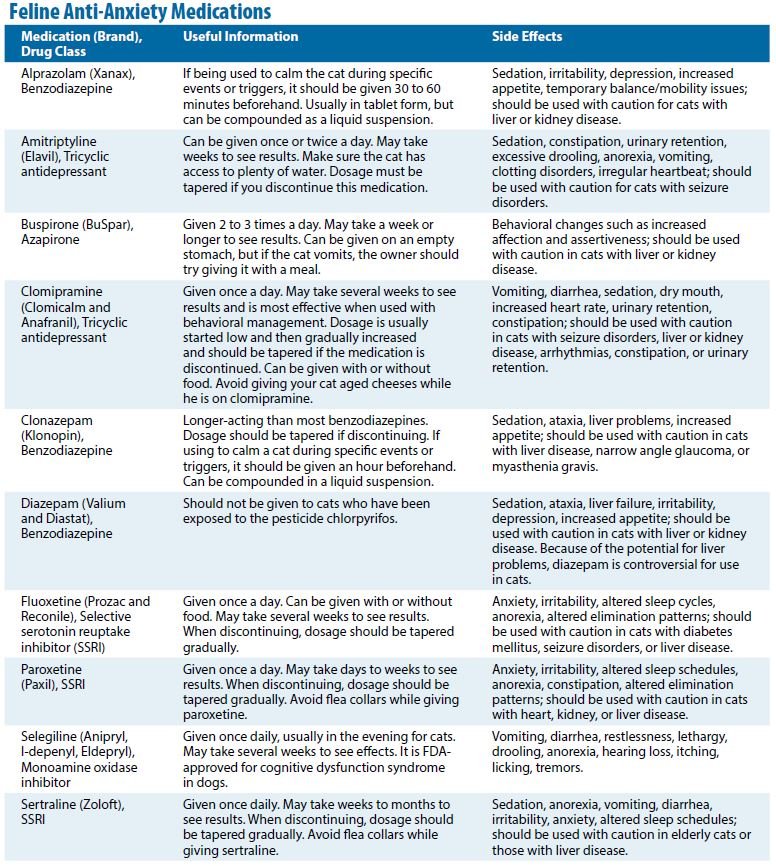While some feline behavior problems can be resolved at least partially with environmental management strategies, sometimes medication becomes necessary. This is often due to behaviors that pose a risk to the cat, owner, or other pets in the household, or may be to simply break the cycle of a very stressed cat. Before you ask for an anti-anxiety medication, you should understand what the drug does and how to use it.
Seeing Results
Many behavioral medications need several weeks to build up sufficient levels in the cat’s system to show effects. If your situation requires more immediate results, your veterinarian may choose a different medication or may initially prescribe two medications for your cat: the one that he or she wants your cat to be on long-term and another that will start working immediately to provide relief while the other medication is building up in the system.
Always follow prescription instructions closely. Cats are sensitive to many medications and giving too much or too frequently often could cause an overdose. Likewise, not giving the medication on the recommended schedule could decrease its effectiveness.
If you have trouble medicating your cat, tell your veterinarian your concerns. Pill guns and pockets are useful for getting pills into cats, but you also can investigate different formulation options that may be more appealing to your cat. Some medications can be compounded with flavoring, such as catnip or chicken. Others can be sprinkled on your cat’s food or made into a gel that can be absorbed through the skin on your cat’s ear. If you can’t give a medication twice a day, ask about once-daily alternatives.
Types of Medication
The five classes of drugs used most commonly for feline anxiety disorders are azapirones, benzodiazepines, monoamine oxidase inhibitors, tricyclic antidepressants, and selective serotonin reuptake inhibitors.
Azapirones stimulate serotonin receptors and block some adrenergic receptors. Serotonin levels have been linked to depression and anxiety, and adrenergic receptors stimulate fight-or-flight behaviors. Stimulating serotonin can be beneficial for your cat’s mental state, while blocking adrenergic receptors helps to keep her calm. Azapirones are not addictive and have a low potential for abuse by humans.
Benzodiazepines enhance the effects of gamma-Aminobutyric acid (GABA), a neurotransmitter that causes sedation and muscle relaxation, among other things. These medications work fast but also have a potential for abuse.
Monoamine oxidase inhibitors (MAOIs) allow the neurotransmitters serotonin, dopamine, and norepinephrine (adrenaline) to stay active within the brain longer (monoamine oxidase removes these neurotransmitters).
Tricyclic antidepressants (TCAs) also prevent the removal of serotonin and norepinephrine from the brain.
Selective serotonin reuptake inhibitors (SSRIs) work by preventing the removal (or reuptake) of serotonin within the brain. One of the advantages to these medications is that they seem to specifically target serotonin, while other neurotransmitters are unaffected.
Every medication has the potential for drug interactions, so it is important to notify your veterinarian of any and all medications and supplements that your cat may be taking.
Depending on the cause and severity of your cat’s anxiety disorder, anti-anxiety medication may be a short-term solution to alleviate symptoms while you make adjustments to his environment to decrease stress, or it may be a long-term medication that he receives for the rest of his life. With most long-term medications, your veterinarian will want to do bloodwork every six to 12 months to monitor liver and kidney function. This regular bloodwork is important to make sure that the medication is not impacting the rest of your cat’s body in a negative way and allows you to catch any developing problems early.
Click on image to enlarge





